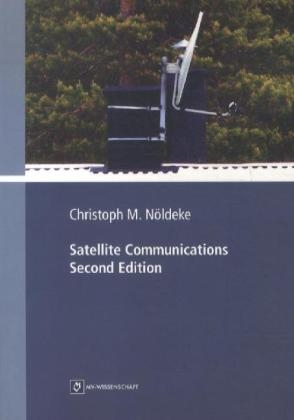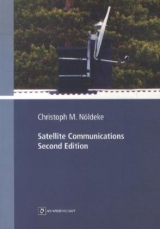Satellite Communications
Seiten
2013
Monsenstein und Vannerdat (Verlag)
978-3-86991-401-5 (ISBN)
Monsenstein und Vannerdat (Verlag)
978-3-86991-401-5 (ISBN)
- Titel ist leider vergriffen;
keine Neuauflage - Artikel merken
Since half a century, geostationary satellites have been playing an ever increasing role in global communications. While early pioneers focused on the use of spacecraft as means for combat or imagined manned space flight, the idea to communicate over geostationary satellites was first expressed by the British writer Arthur C. Clarke, who later became famous for his novel "2001, A Space Odyssey". Shortly after the end of World War II, in October 1945, he asked the following question: "Extra-terrestrial relays - can rocket stations give worldwide radio coverage?"
Clarke was impressed by the rocket technology developed by the German military and imagined possible orbits around the earth. His analysis was to the point:
"It will be observed that one orbit, with a radius of 42,000 km, has a period of exactly 24 hours. A body in such an orbit, if its plane coincided with that of the earth's equator, would revolve with the earth and would thus be stationary above the same spot on the planet. It would remain fixed in the sky of a whole hemisphere and unlike all other heavenly bodies would neither rise nor set."
He imagined further how space stations could be assembled and equipped:
"Using material ferried up by rockets, it would be possible to construct a 'space-station' in such an orbit. It could be provided with receiving and transmitting equipment.and could act as a repeater to relay transmissions between any two points on the hemisphere beneath, using any frequency which will penetrate the ionosphere. If directive arrays were used, the power requirements would be very small, as direct line of sight transmission would be used."
Strikingly enough in 1945, he already provided very precise recommendations for the frequency bands to be used, the number of stations required for world wide coverage, and predicted the feasibility of intersatellite links:
"It seems fairly certain that frequencies from, say, 50 Mc/s to 100,000 Mc/s could be used without undue absorption in the atmosphere or the ionosphere. A single station could only provide coverage to half the globe, and for a world service three would be required, though more could be readily utilised. The stations. would be linked by radio or optical beams, and thus any conceivable beam or broadcast service could be provided."
Unlike manned flights to the moon, which where announced 16 years later by US president John F. Kennedy and which today are history, most of Clarke's predictions still are of utmost everyday importance. Kennedy, on the other hand, was well aware of the potential of global access to communications which is provided by satellites. He was the first politician ever who used a satellite, Telstar 1, as a medium for propagation of his speeches in 1962.
The first communication satellite in 1960 was a metal covered balloon named "ECHO" which reflected radio signals back to earth, followed by the first geostationary satellite "Syncom 2" which already was equipped with an active repeater and could carry two duplex voice channels.
The begin of commercial use of Satcom technology is marked by the first intercontinental transmission of sports events during the Olympic Games in Tokyo 1964 and the founding of INTELSAT shortly after.
Today, the geostationary orbit is plastered with satellites, carrying tens of thousands of transponders. While the capacity of terrestrial links has been constantly increasing with the introduction of multi-gigabit glass fiber links, Satcom has preserved its unique quality as a global access medium via the air interface, sharp-mindedly predicted by Clarke. Not only can trunk communication links be established in an extremely flexible manner by simply setting up a ground terminal and contracting the air interface access with a satellite operator, Satcom also provides direct voice and data service over the oceans and to the most remote terrestrial sites where neither land line nor cell phone services are available.
Remarkably enough, albeit a spaceborne technology, Satcom provides service to Earth and its inhabitants. The author feels that, in view of upcoming common global challenges, the importance of satellite communications will increase. Learning about Satcom therefore is a good investment for students, young scientists and engineers!
Clarke was impressed by the rocket technology developed by the German military and imagined possible orbits around the earth. His analysis was to the point:
"It will be observed that one orbit, with a radius of 42,000 km, has a period of exactly 24 hours. A body in such an orbit, if its plane coincided with that of the earth's equator, would revolve with the earth and would thus be stationary above the same spot on the planet. It would remain fixed in the sky of a whole hemisphere and unlike all other heavenly bodies would neither rise nor set."
He imagined further how space stations could be assembled and equipped:
"Using material ferried up by rockets, it would be possible to construct a 'space-station' in such an orbit. It could be provided with receiving and transmitting equipment.and could act as a repeater to relay transmissions between any two points on the hemisphere beneath, using any frequency which will penetrate the ionosphere. If directive arrays were used, the power requirements would be very small, as direct line of sight transmission would be used."
Strikingly enough in 1945, he already provided very precise recommendations for the frequency bands to be used, the number of stations required for world wide coverage, and predicted the feasibility of intersatellite links:
"It seems fairly certain that frequencies from, say, 50 Mc/s to 100,000 Mc/s could be used without undue absorption in the atmosphere or the ionosphere. A single station could only provide coverage to half the globe, and for a world service three would be required, though more could be readily utilised. The stations. would be linked by radio or optical beams, and thus any conceivable beam or broadcast service could be provided."
Unlike manned flights to the moon, which where announced 16 years later by US president John F. Kennedy and which today are history, most of Clarke's predictions still are of utmost everyday importance. Kennedy, on the other hand, was well aware of the potential of global access to communications which is provided by satellites. He was the first politician ever who used a satellite, Telstar 1, as a medium for propagation of his speeches in 1962.
The first communication satellite in 1960 was a metal covered balloon named "ECHO" which reflected radio signals back to earth, followed by the first geostationary satellite "Syncom 2" which already was equipped with an active repeater and could carry two duplex voice channels.
The begin of commercial use of Satcom technology is marked by the first intercontinental transmission of sports events during the Olympic Games in Tokyo 1964 and the founding of INTELSAT shortly after.
Today, the geostationary orbit is plastered with satellites, carrying tens of thousands of transponders. While the capacity of terrestrial links has been constantly increasing with the introduction of multi-gigabit glass fiber links, Satcom has preserved its unique quality as a global access medium via the air interface, sharp-mindedly predicted by Clarke. Not only can trunk communication links be established in an extremely flexible manner by simply setting up a ground terminal and contracting the air interface access with a satellite operator, Satcom also provides direct voice and data service over the oceans and to the most remote terrestrial sites where neither land line nor cell phone services are available.
Remarkably enough, albeit a spaceborne technology, Satcom provides service to Earth and its inhabitants. The author feels that, in view of upcoming common global challenges, the importance of satellite communications will increase. Learning about Satcom therefore is a good investment for students, young scientists and engineers!
| Erscheint lt. Verlag | 1.2.2013 |
|---|---|
| Reihe/Serie | MV Wissenschaft |
| Sprache | englisch |
| Maße | 170 x 240 mm |
| Gewicht | 406 g |
| Einbandart | Paperback |
| Themenwelt | Sachbuch/Ratgeber ► Natur / Technik ► Technik |
| Schlagworte | Analysis • Geostationary satellites • Global Communications • Satellitenkommunikation |
| ISBN-10 | 3-86991-401-7 / 3869914017 |
| ISBN-13 | 978-3-86991-401-5 / 9783869914015 |
| Zustand | Neuware |
| Haben Sie eine Frage zum Produkt? |
Mehr entdecken
aus dem Bereich
aus dem Bereich
die wichtigsten Begriffe, Bautypen und Bauelemente
Buch | Softcover (2024)
Prestel (Verlag)
CHF 44,75
Buch | Hardcover (2021)
C. Bertelsmann (Verlag)
CHF 25,20
vom Kolosseum über die Akropolis bis zur Alhambra
Buch | Hardcover (2023)
DK (Verlag)
CHF 29,90




